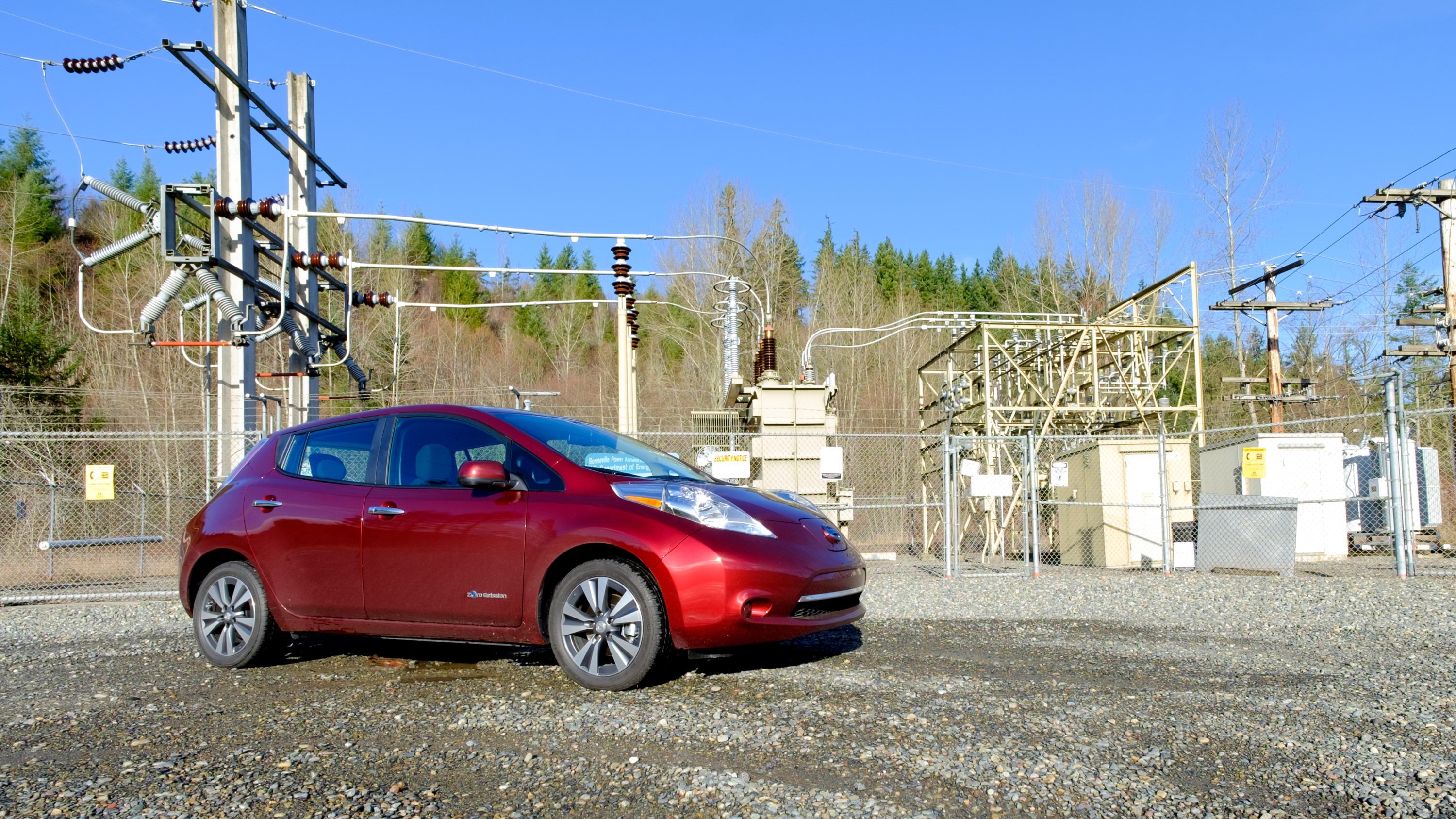TechRadar Verdict
The new battery pack in the 2016 Leaf may entice more buyers to embrace the electric car, but the car lacks in infotainment and driver assist technologies.
Pros
- +
New 30 kWh battery
- +
Quick charging technology
- +
360-degree camera
Cons
- -
Infotainment system
- -
Bose premium sound
- -
Fit and finish
Why you can trust TechRadar
Update: NissanConnect EV services via mobile apps are restored. The security vulnerability has been fixed and an updated version of the app is now available.
Electricity-powered cars predated gasoline cars by about 50 years and even outsold gasoline cars toward the tail end of the 19th century. It's hard to imagine that electric vehicles were once a common sight (by 19th century standards) in today's gasoline-dominated market. While we're at an epoch of automotive innovation, performance and efficiency, oil is a finite resource that will eventually run out.
There are two paths to alternative propulsion, and the automotive industry is split between hydrogen and electric vehicles (EV). Nissan is placing its bet on electrification and unleashed the leading environmentally-friendly, affordable family car (Leaf) to the world in 2010.
The Leaf received incremental updates with new features, a change of production to Nissan's Smyrna, Tenn. manufacturing plant, and revised battery chemistry throughout the last five years, but the battery capacity and infotainment system remained the same, until now. New for the 2016 model year Leaf SV and SL trims is a 30 kWh battery, up from the 24 kWh on the base S trim and previous years, bringing the total range rating up to 107-miles, from 84, of gasoline-free driving.
Nissan sent techradar a 2016 Leaf SV with premium package with an MSRP of $36,620 (£25,640 for the similarly equipped Acenta trim, Australia only has one trim for AU$40,000) for a week of gasoline-free driving.
Before I go on about the car, it should be known that I bought my wife a 2015 Leaf SL with premium package a year ago. We've been happy with the car and quite familiar with the public EV infrastructure in Washington State. However, EV ownership is a difference experience that required changing driving habits and greater planning, which I will no doubt elaborate on.
Styling isn't a strong point for the Leaf. The front end reminds me of a Pokemon, Bulbasaur specifically, with giant headlights and a smirky grin. Halogen headlights with reflector housings are standard on the Leaf SV, but stepping up to the SL trim gets you more energy-efficient, LED low-beams, if you want to consume less energy at night. My experience with the halogens in the SV and LED in my personal SL yield minimal lighting gains. Both headlights rely on reflector housings and are a far cry from matching the light output of projector-based halogen, high-intensity discharge (HID) or more powerful LEDs.
Sign up for breaking news, reviews, opinion, top tech deals, and more.

Moving around back reveals giant LED tail lights that remind me of old Volvo station wagons. The sloped rear hatch theoretically helps aerodynamics, but you do lose out on cargo capacity compared to the more rectangular station wagon look, which I prefer.
The design cue I dislike the most on the Leaf is the chrome door handles. I despise chrome trim on all modern cars, especially on door handles, because it's a fingerprint magnet. Installing something prone to showing fingerprints on the most frequently touched area of a car is a pet peeve of mine. However, the door handles is the only area with a design change with the refresh – the door lock and unlock button is now black instead of chrome like previous model years.
Interior
Step inside and you'll find a spartan interior that belongs in a budget-priced subcompact more so than a car that costs north of $30,000. The dashboard is devoid of soft-touch materials and covered in cheap, hard plastic. Fortunately, the door panel and center armrests are covered with soft cloth to help comfort when cruising along.
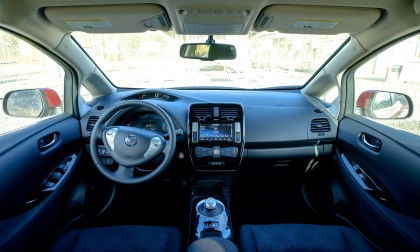
Look forward and you'll see a two-tier digital cluster that separates the speedometer from the vehicle information. While the cluster is digital, per se, it reminds me of the '80s digital gauge clusters instead of the modern LCD displays found in current cars.
It looks plain but very functional with a digital speedometer, clock and outside air temperature. The high placement of the speedometer keeps it within your peripheral vision while focusing on the road, which is helpful, because the distance you can travel with an EV highly varies on the speed. The left side of the digital cluster is an eco-meter that "builds trees" to show how efficient your driving is. My driving isn't very efficient, so not many trees appear during my driving.
The traditional gauge cluster directly in front of the steering wheel features a vehicle information display, battery temperature, battery capacity, range estimate and how much power is consumed relative to the accelerate pedal use, all useful information to have when driving an EV. The information display serves as a digital trip meter, but also shows the battery percentage, charging time and access to vehicle settings.
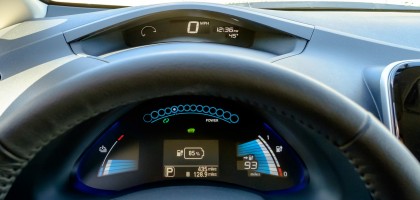
I leave the display on the battery percentage display most of the time, so I have a more accurate idea of how much battery is left, because the estimated range displayed is extremely optimistic and should be taken lightly.
One thing you'll have to get used to in the Nissan Leaf is the shifter – it's completely different from the PRNDL layout of traditional automatic transmissions. Instead, it's a spherical shifter with a dedicated park button. Operating the shifter is easy and didn't take very long for me to get used. Nissan provides a graphic that shows how to operate it directly below.
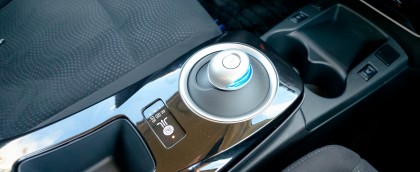
There are reverse, neutral and drive functions. To put the car into gear, you move the shifter to the left and up or down. When the car is in drive, you can move the shifter left and down again for more aggressive regenerative braking, which I'll talk about in the next page. Putting the car in park simply requires stopping the car and pressing the P button in the center of the shifter.
Lastly, I want to mention the seats. The Leaf doesn't have sport seats with amazing side bolster support, which I prefer in every car, but the seats are very comfortable. There isn't a lumbar adjustment, but the the lower back arch and firmness contours well to my 5'7" and 195-pound frame. They have the right amount of firmness and plushness for comfortably long drives without inducing aches, pains or fatigue.
The seats are heated and get toasty, too. Nissan even heats the steering wheel, which gets uncomfortably hot quickly. The Leaf's heated seats and steering wheel help warm up your body faster while consuming less energy than the car's already-efficient heat-pump-based climate system, which theoretically aids driving range.
Infotainment system
New for 2016 is the NissanConnect infotainment system that brings the Leaf up to date with the rest of Nissan's model lineup. Nissan kept the 7-inch screen size and buttons exactly the same as the previous model years. In fact, there are no visual interior differences between 2015 and 2016 models, when the car is off at least.
The double-din-sized infotainment system features a screen that opens and tilts to reveal a CD player and SD card slot for the navigation maps. A USB port in front of the cup holders is available for flash drives and iOS device connectivity. SiriusXM, HD Radio and NissanConnect EV telematics rounds out the complete package.
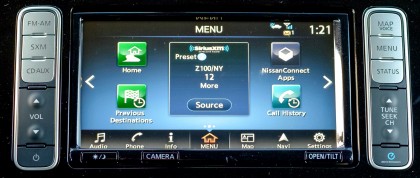
Audio functions are straight-forward with no surprises. Music stored on flash drives can be navigated by track data or folders. The one music navigating function of all Nissan and Infiniti infotainment systems is still there – when you select a music folder, it immediately begins playing it instead of just opening the folder to let you pick a song first. SiriusXM and HD Radio functions are basic and work without time-shifting capabilities.
I tested the USB port power output capabilities using a Drok USB power meter with my Nexus 6 and iPhone 6S. Power output was 0.8-amps with the iPhone 6S and 0.5-amps with the Nexus 6. While the NissanConnect system can charge iPhone's at a decent rate, you're better off using a 12-volt USB charger or USB power bank for Android devices.
Nissan's updated user interface is more visually pleasing with better graphics that are highly customizable, but it's a clunky mess. There's simply too much customization available. The home screen lets you choose and pick what functions and widgets are displayed on three separate screens.
I prefer the simpler, split home screen in the Kia Optima, Hyundai Tucson and Toyota's since they display radio information, a small navigation map and a couple functional buttons, whereas the NissanConnect UI has a 4 x 2 grid layout. While the NissanConnect 4 x 2 grid is customizable, each information display occupies a 2 x 2 space and each button takes up one spot, so you can either have two information displays or four buttons with one information display.
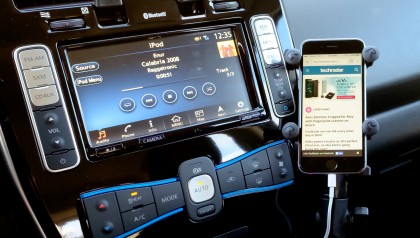
Sure, three home screens are available, but I don't like fiddling around with the infotainment system for information that I should be able to see at a single glance. Nissan deserves credit for keeping static menu functions at the bottom of the screen for audio, phone, information, map, navigation and settings functions, but everything is replicated by physical buttons on each side of the display.
As much of a fan I am of physical buttons, I'd rather see a larger 4:3 ratio screen with knobs for volume and folder navigation than having the same buttons on and off screen.
Visual nuances aside, NissanConnect includes smartphone app connectivity, but the function is extremely limited. By extremely limited, I mean it only supports Google Online Search with the NissanConnect app installed on your smartphone. There's no Pandora or other Internet radio support, unfortunately.
Bluetooth is available for hands-free voice, music streaming and text messaging. I paired my Nexus 6 and iPhone 6S without any issues. Text messaging support is quite worthless – it can read you text messages and present you with quick replies, but you're better off using Google Now or Siri for those purposes. Siri Eyes Free isn't supported, annoyingly.
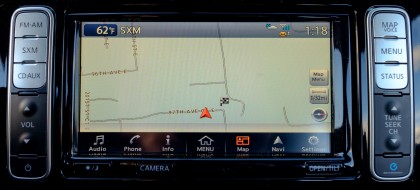
Nissan incorporates EV-friendly features with the navigation software to show nearby charging stations and an estimated radius of where you can travel with the available charge. They're nice gestures, but the charging station database is severely outdated and doesn't even list some of the dealerships that have Level 3 CHAdeMo quick-charge stations.
You're better off using the Nissan EZ-Charge app for smartphones or PlugShare to find an up to date charging station list with user reviews and check ins. The navigation maps are your standard fare flat maps, with different available route calculations that can optimize the trip for maximum battery range (slow surface streets mostly).
While mapping a route for maximum battery range is convenient, I'm not the type of person to use the navigation functions for places I frequently visit, so I'm not really open to taking alternative routes or driving mostly on the streets when the freeway is available, just to save some battery life.
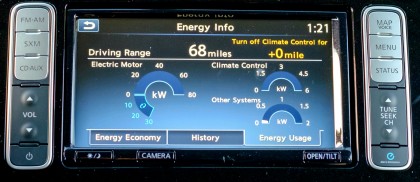
Previous Leaf owners will find the Zero Emission functions identical to the older infotainment system. Nissan essentially transplanted the same functions and interface to the new infotainment system. The Zero Emission functions provides greater energy consumption information for the electric motor, climate control and other items. It even estimates how much range you can gain by turning off climate control.
I find the information convenient to have on hot days where blasting the A/C can make the difference of making it to the next charging station or being towed there, on longer drives.
Current page: Design, interior and infotainment
Next Page NissanConnect EV, Audio and Around View Monitor